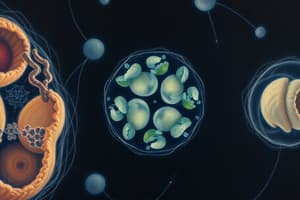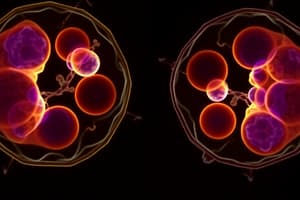Podcast
Questions and Answers
A female with a mitochondrial disorder gives birth to a son. What is the probability that the son will inherit the mitochondrial disorder?
A female with a mitochondrial disorder gives birth to a son. What is the probability that the son will inherit the mitochondrial disorder?
- 100% (correct)
- 50%
- 0%
- 25%
Which of the following is NOT a characteristic of mitosis?
Which of the following is NOT a characteristic of mitosis?
- Involves the condensation of chromosomes
- Used for growth and repair of tissues
- Involves the separation of homologous chromosomes (correct)
- Produces two identical daughter cells
- Occurs in somatic cells
A pedigree shows an autosomal dominant trait with affected individuals in every generation. What is the most likely explanation for this pattern of inheritance?
A pedigree shows an autosomal dominant trait with affected individuals in every generation. What is the most likely explanation for this pattern of inheritance?
- Affected individuals are homozygous recessive
- The trait is X-linked recessive
- Affected individuals are always homozygous dominant
- The trait is X-linked dominant
- Affected individuals are heterozygous dominant (correct)
Which of the following is a key difference between meiosis and mitosis?
Which of the following is a key difference between meiosis and mitosis?
A researcher is studying the effects of a new drug on cell division. The experiment involves treating cells with the drug and then analyzing the number of cells in each stage of the cell cycle. What is the most appropriate statistical test to use to analyze the data?
A researcher is studying the effects of a new drug on cell division. The experiment involves treating cells with the drug and then analyzing the number of cells in each stage of the cell cycle. What is the most appropriate statistical test to use to analyze the data?
Which of the following stages of the cell cycle would a cell be in if it is spending the majority of its time in the G1 phase?
Which of the following stages of the cell cycle would a cell be in if it is spending the majority of its time in the G1 phase?
What is the role of microtubules during mitosis?
What is the role of microtubules during mitosis?
Which of the following processes is directly responsible for increasing genetic diversity during meiosis?
Which of the following processes is directly responsible for increasing genetic diversity during meiosis?
What is the significance of the Cdk-cyclin complex (MPF) in cell division?
What is the significance of the Cdk-cyclin complex (MPF) in cell division?
How does the law of independent assortment contribute to genetic diversity during meiosis?
How does the law of independent assortment contribute to genetic diversity during meiosis?
A cell with a mutation that prevents the formation of a functional Cdk-cyclin complex would likely have what effect on cell division?
A cell with a mutation that prevents the formation of a functional Cdk-cyclin complex would likely have what effect on cell division?
Which of the following best describes the purpose of crossing over?
Which of the following best describes the purpose of crossing over?
Which of the following is an example of a mutation that could potentially contribute to cancer development?
Which of the following is an example of a mutation that could potentially contribute to cancer development?
In a monohybrid cross, a homozygous dominant parent (AA) is crossed with a homozygous recessive parent (aa). What is the expected genotype ratio of the offspring?
In a monohybrid cross, a homozygous dominant parent (AA) is crossed with a homozygous recessive parent (aa). What is the expected genotype ratio of the offspring?
A dihybrid cross involves two genes. If a plant with the genotype AaBb is crossed with another plant with the genotype AaBb, what is the expected phenotypic ratio of the offspring?
A dihybrid cross involves two genes. If a plant with the genotype AaBb is crossed with another plant with the genotype AaBb, what is the expected phenotypic ratio of the offspring?
A test cross is performed to determine the genotype of an organism with an unknown genotype. Which of the following genotypes would be used for the test cross?
A test cross is performed to determine the genotype of an organism with an unknown genotype. Which of the following genotypes would be used for the test cross?
During meiosis, crossing over can occur between homologous chromosomes. What is the primary outcome of this process?
During meiosis, crossing over can occur between homologous chromosomes. What is the primary outcome of this process?
If a gene exhibits epistasis, what can we infer about its relationship with other genes?
If a gene exhibits epistasis, what can we infer about its relationship with other genes?
A pedigree chart shows three generations of a family, with individuals affected by an autosomal recessive trait. What is the most likely genotype of an unaffected individual in the second generation who has one affected parent?
A pedigree chart shows three generations of a family, with individuals affected by an autosomal recessive trait. What is the most likely genotype of an unaffected individual in the second generation who has one affected parent?
Two genes that are located on the same chromosome are considered linked genes. What is the primary factor that affects the likelihood of linked genes being inherited together?
Two genes that are located on the same chromosome are considered linked genes. What is the primary factor that affects the likelihood of linked genes being inherited together?
If the observed frequency of recombination between two linked genes is 10%, what is the map unit distance between them?
If the observed frequency of recombination between two linked genes is 10%, what is the map unit distance between them?
Flashcards
Sex-Linked Pedigree Chart
Sex-Linked Pedigree Chart
A diagram showing inheritance patterns of traits linked to sex chromosomes.
Mitochondrial DNA Inheritance
Mitochondrial DNA Inheritance
Only mothers pass mitDNA traits to all offspring.
Cell Cycle Checkpoints
Cell Cycle Checkpoints
Regulatory points in the cell cycle (G1, S, G2, M) that ensure proper division.
Chi-Square Analysis
Chi-Square Analysis
Signup and view all the flashcards
Mitosis vs Meiosis
Mitosis vs Meiosis
Signup and view all the flashcards
Stages of Mitosis
Stages of Mitosis
Signup and view all the flashcards
Microtubules in Mitosis
Microtubules in Mitosis
Signup and view all the flashcards
G0 Stage
G0 Stage
Signup and view all the flashcards
Cdk-Cyclin Complex (MPF)
Cdk-Cyclin Complex (MPF)
Signup and view all the flashcards
Cancer and Cell Division
Cancer and Cell Division
Signup and view all the flashcards
Crossing Over
Crossing Over
Signup and view all the flashcards
Independent Assortment
Independent Assortment
Signup and view all the flashcards
DNA Content in Cells
DNA Content in Cells
Signup and view all the flashcards
Zygote Interphase
Zygote Interphase
Signup and view all the flashcards
Mitosis
Mitosis
Signup and view all the flashcards
Dominant Allele
Dominant Allele
Signup and view all the flashcards
Monohybrid Cross
Monohybrid Cross
Signup and view all the flashcards
Dihybrid Cross
Dihybrid Cross
Signup and view all the flashcards
Test Cross
Test Cross
Signup and view all the flashcards
Epistasis
Epistasis
Signup and view all the flashcards
Autosomal & Sex-linked Genotypes
Autosomal & Sex-linked Genotypes
Signup and view all the flashcards
Study Notes
Mitosis and Meiosis
- Identifying the events of each stage of mitosis, including the role of microtubules.
- Interpreting data representing the rate at which cells move through the cell cycle, noting that cells spending no time in S, G2, or Mitosis must spend all time in G1.
- Identifying the Go stage of the cell cycle, where cells are not actively dividing.
- Describing the role of the Cdk-cyclin complex (MPF) in cell division, including the inactive state where mitosis and division stop.
- Identification of mutations that cause cancerous tumors, focusing on excessive cell division.
- Describing crossing over and how it increases genetic diversity in meiosis.
- Impact of independent assortment in meiosis I on genetic diversity.
Chromosome Arrangement in Meiosis
- Identifying chromosome arrangement in each stage of meiosis (Interphase, Prophase I, Metaphase I, Anaphase I, Telophase I, Cytokinesis, Prophase II, Metaphase II, Anaphase II, Telophase II, Cytokinesis)
Calculating DNA Amounts
- Calculating the amount of DNA in a cell during interphase, mitosis, and meiosis.
- Identifying DNA amounts in different cell types (somatic, zygote, gamete, cell entering mitosis)
Inheritance Patterns
- Identifying dominant and recessive alleles from data.
- Describing and identifying epistasis as a genetic phenomenon.
- Identifying genotypes as either autosomal or sex-linked.
- Determining the genotypes of parents from offspring data.
- Identifying whether genes are on the same or different chromosomes, noting the inheritance of linked genes.
Pedigree Charts
- Interpreting sex-linked and autosomal recessive pedigree charts.
- Recognizing inheritance patterns of autosomal dominant diseases.
Mitochondrial DNA
- Describing the inheritance of mitochondrial DNA.
Cell Cycle Control Checkpoints
- Explaining the sections of interphase (G1, G2, and S) and the cell cycle control checkpoints (Cdk, cyclin, MPF).
- Analyzing experiments on environmental effects on mitosis.
- Completing chi-square analyses and interpreting results.
Mitosis & Meiosis Similarities
- Describing similarities and differences between mitosis and meiosis, including the production of gametes.
- Graphing and interpreting data from meiosis experiments.
- Relating meiosis to dihybrid crosses and predicting expected gametes and phenotypes.
Pedigree Analysis
- Analyzing pedigrees to determine inheritance patterns.
Studying That Suits You
Use AI to generate personalized quizzes and flashcards to suit your learning preferences.




